Experimental Study on the Impact of High-Frequency Vibration Excitation on Coal Fracturing
Abstract
1. Introduction
2. Materials and Methods
2.1. Establishment of the Particle Flow Model
2.2. Experimental Equipment and Procedures
3. Results
3.1. Evolution of NMR T2 Spectra of Coal Samples Under Ultrasonic Vibration
3.2. Evolution of Porosity and Permeability of Coal Samples under Ultrasonic Vibration Excitation
3.3. Multifractal Characterization of Pore Structure in Coal Samples
3.3.1. Multifractal Theory Based on NMR
3.3.2. Multifractal Characteristics
4. Discussion and Conclusions
- (1)
- The natural frequency of a coal sample is inversely proportional to its mass. By adjusting the size of a cylindrical coal sample to have a diameter of 25 mm and height of 30 mm, we determined that its natural frequency reaches 15 kHz, enabling resonance under vibration system excitation.
- (2)
- High-frequency vibration stimulation promotes the development of micropores and mesopores in the coal sample, with porosity and permeability showing positive correlation with stimulation time index. Within 40 s of excitation, porosity increased by at least 32.4%, while permeability increased by more than two orders of magnitude.
- (3)
- At an equal exciting time (40 s), the resonance state exhibited increments in porosity and permeability that were 5 times and 8.4 times higher than those observed in the non-resonance state, respectively. Seepage behavior and cracking efficiency were significantly enhanced during the resonance state compared to the non-resonance state.
- (4)
- Multifractal parameters can effectively reflect pore size distribution characteristics in coal samples while characterizing complexity within their distribution patterns; ΔD(q)and Δα are directly mesopores as well as macropores, but are inversely proportional to micropores proportionally; conversely, Δf exhibits opposite trends.
Author Contributions
Funding
Data Availability Statement
Acknowledgments
Conflicts of Interest
References
- Zhang, S.; Zhang, D.; Feng, G.; Chi, M.; Bar-Cohen, Y. Modelling method of heterogeneous rock mass and DEM investigation of seepage characteristics. Geomech. Geophys. Geo-Energy Geo-Resour. 2024, 10, 46. [Google Scholar] [CrossRef]
- Zhu, D.; Yu, B.; Wang, D.; Zhang, Y. Fusion of finite element and machine learning methods to predict rock shear strength parameters. J. Geophys. Eng. 2024, 21, 1183–1193. [Google Scholar] [CrossRef]
- Fan, Z.; Fan, G.; Zhang, D.; Zhang, L.; Zhang, S.; Liang, S.; Yu, W. Optimal Injection Timing and Gas Mixture Proportion for Enhancing Coalbed Methane Recovery. Energy 2021, 222, 119880. [Google Scholar] [CrossRef]
- Fan, Z.; Fan, G.; Zhang, D. Representation of mining permeability and borehole layout optimization for efficient methane drainage. Energy Rep. 2021, 7, 3911–3921. [Google Scholar] [CrossRef]
- Gao, R.; Kuang, T.; Meng, X.; Huo, B. Effects of ground fracturing with horizontal fracture plane on rock breakage characteristics and mine pressure control. Rock Mech. Rock Eng. 2021, 54, 3229–3243. [Google Scholar] [CrossRef]
- Gao, R.; Bai, D.; Yu, B.; Tai, Y.; Meng, X.; Zhang, W. Ground fracturing of multi-strata for strong ground pressure control in extra-thick coal seams with hard roofs: Numerical simulation and case study. Eng. Fract. Mech. 2024, 303, 110129. [Google Scholar] [CrossRef]
- Fan, Z.; Fan, G.; Zhang, D. Permeability and Energy Evolution Characteristics of Heterogeneous Coal and Rock Mass. Nat. Resour. Res. 2021, 30, 4493–4514. [Google Scholar] [CrossRef]
- Zhao, D.; Wang, M.; Gao, X. Study on the technology of enhancing permeability by deep hole presplitting blasting in Sanyuan coal mine. Sci. Rep. 2021, 11, 20353. [Google Scholar] [CrossRef] [PubMed]
- Cai, F.; Liu, Z. Intensified extracting gas and rapidly diminishing outburst risk using deep-hole presplitting blast technology before opening coal seam in shaft influenced by fault. Procedia Eng. 2011, 26, 418–423. [Google Scholar]
- Guo, C.; Feng, Q.; Ma, T.; Wang, S.; Zhou, R.; Wang, B. Coupled flow-geomechanics studies on the role of hydrofracturing and secondary fracturing in CO2-enhanced coalbed methane. Energy Explor. Exploit. 2021, 39, 1622–1639. [Google Scholar] [CrossRef]
- Zou, Q.; Liu, H.; Jiang, Z.; Wu, X. Gas flow laws in coal subjected to hydraulic slotting and a prediction model for its permeability-enhancing effect. Energy Sources Part A-Recovery Util. Environ. Eff. 2021, 2021, 1936692. [Google Scholar] [CrossRef]
- Zhao, D.; Zhang, S.; Wang, M. Microcrack Growth Properties of Granite under Ultrasonic High-Frequency Excitation. Adv. Civ. Eng. 2019, 2019, 3069029. [Google Scholar] [CrossRef]
- Han, J.; Zhao, D.; Zhang, S.; Zhou, Y. Damage Evolution of Granite under Ultrasonic Vibration with Different Amplitudes. Shock Vib. 2022, 2022, 8975797. [Google Scholar] [CrossRef]
- Yin, S.; Zhao, D.; Zhai, G. Investigation into the characteristics of rock damage caused by ultrasonic vibration. Int. J. Rock Mech. Min. Sci. 2016, 84, 159–164. [Google Scholar] [CrossRef]
- Zhou, Y.; Tang, Q.; Zhang, S.; Zhao, D. The Mechanical Properties of Granite under Ultrasonic Vibration. Adv. Civ. Eng. 2019, 2019, 9649165. [Google Scholar] [CrossRef]
- Zhang, L.; Wang, X.; Wang, J.; Yang, Z. Mechanical characteristics and pore evolution of red sandstone under ultrasonic high-frequency vibration excitation. AIP Adv. 2021, 11, 055202. [Google Scholar] [CrossRef]
- Zhang, J.; Zhang, L.; Wang, X.; Niu, Z.; Yang, Z. Influence of High-Frequency Ultrasonic Vibration Load on Pore-Fracture Structure in Hard Rock: A Study Based on 3D Reconstruction Technology. Materials 2024, 17, 1127. [Google Scholar] [CrossRef]
- Bieniawski, Z.; Bernede, M. Suggested methods for determining the uniaxial compressive strength and deform-ability of rock materials. Int. J. Rock Mech. Min. Sci. Geomech. Abstr. 1979, 16, 138–140. [Google Scholar] [CrossRef]
- Li, W.; Yan, T.; Li, S.; Zhang, X. Rock fragmentation mechanisms and an experimental study of drilling tools during high-frequency harmonic vibration. Pet. Sci. 2013, 10, 205–211. [Google Scholar] [CrossRef]
- Wang, F.; Yang, K.; Cai, J. Fractal characterization of tight oil reservoir pore structure using nuclear magnetic resonance and mercury intrusion porosimetry. Fractals-Complex Geom. Patterns Scaling Nat. Soc. 2018, 26, 1840017. [Google Scholar] [CrossRef]
- Xu, H.; Fan, Y.; Hu, F.; Li, C.; Yu, J.; Liu, Z.; Wang, F. Characterization of pore throat size distribution in tight sandstones with nuclear magnetic resonance and high-pressure mercury intrusion. Energies 2019, 12, 1528. [Google Scholar] [CrossRef]
- Ferreiro, J.; Wilson, M.; Vázquez, E. Multifractal description of nitrogen adsorption isotherms. Vadose Zone J. 2009, 8, 209–219. [Google Scholar] [CrossRef]
- Vázquez, E.; Ferreiro, J.; Miranda, J.; González, A. Multifractal analysis of pore size distributions as affected by simulated rainfall. Vadose Zone J. 2008, 7, 500–511. [Google Scholar] [CrossRef]
- Halsey, T.; Jensen, M.; Kadanoff, L.; Procaccia, I.; Shraiman, B. Fractal measures and their singularities: The characterization of strange sets. Phys. Rev. A Gen. Phys. 1986, 33, 1141–1151. [Google Scholar] [CrossRef] [PubMed]

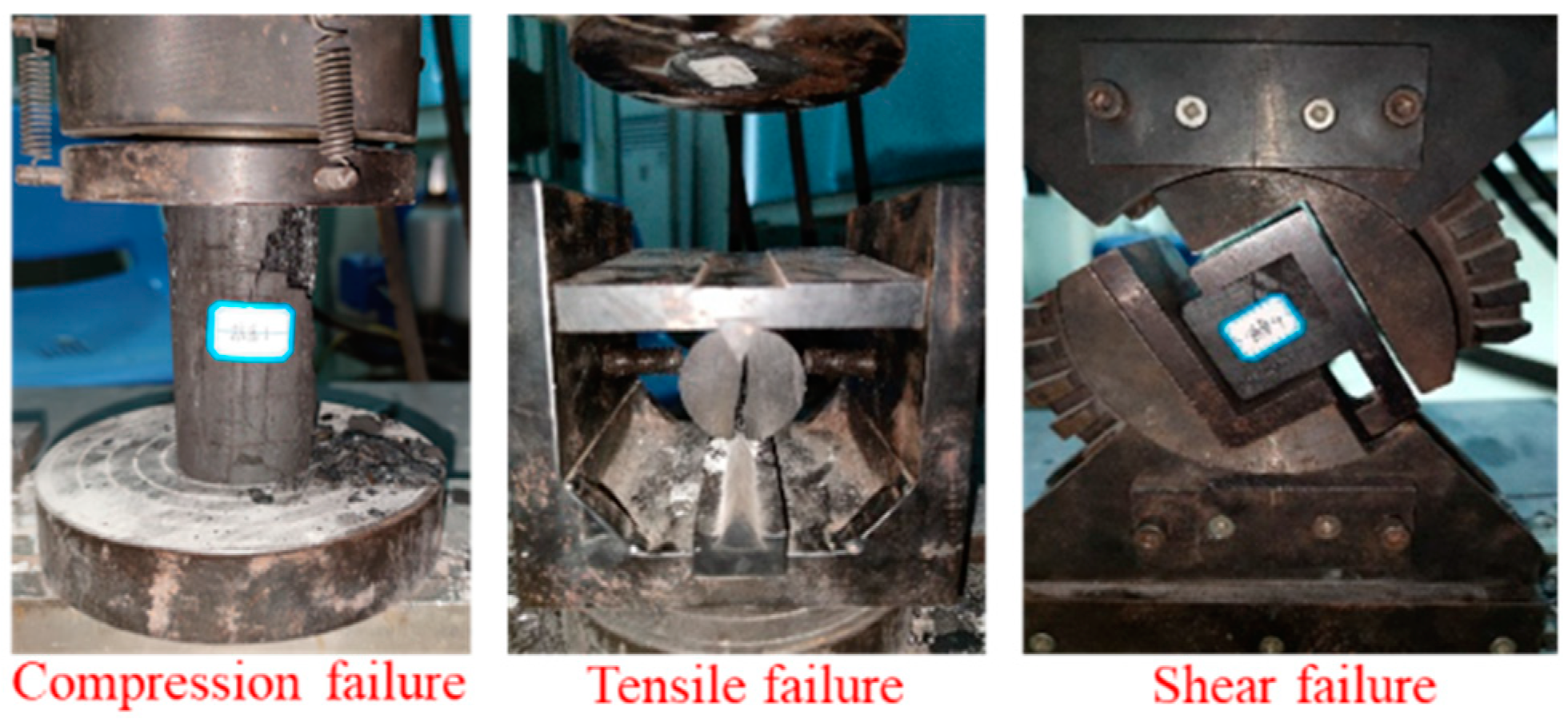
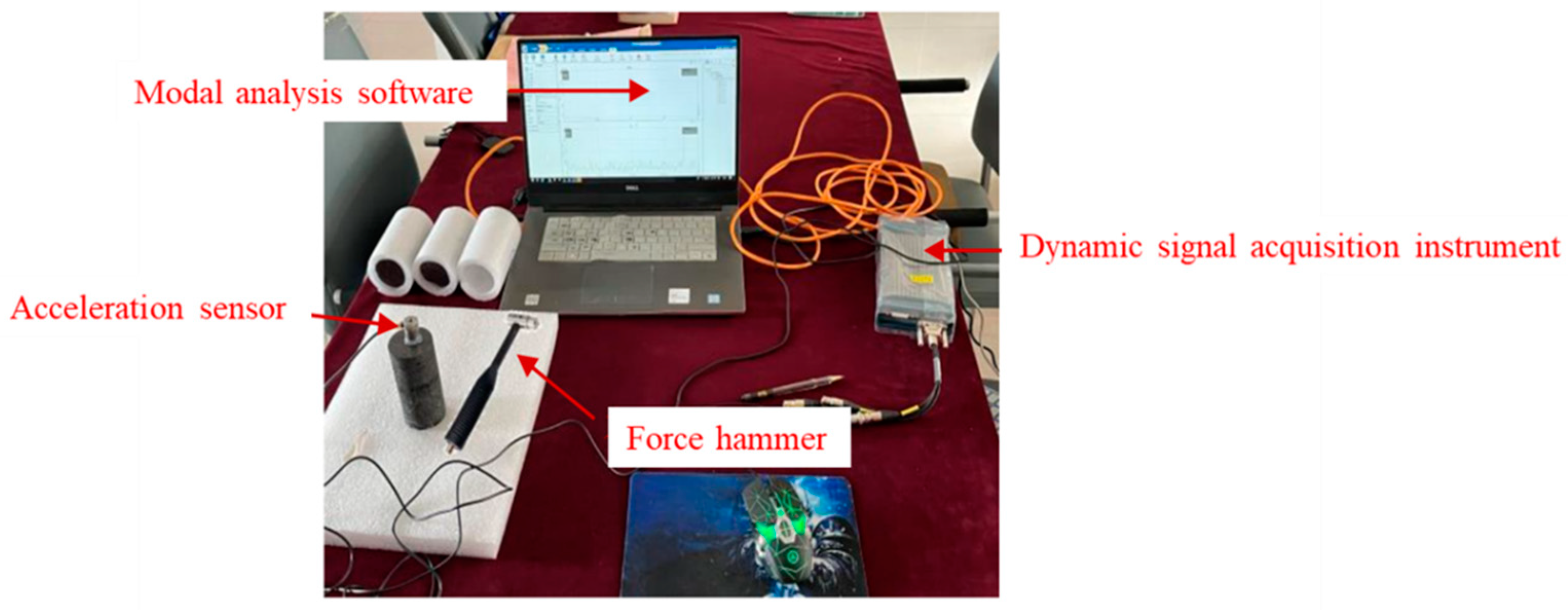
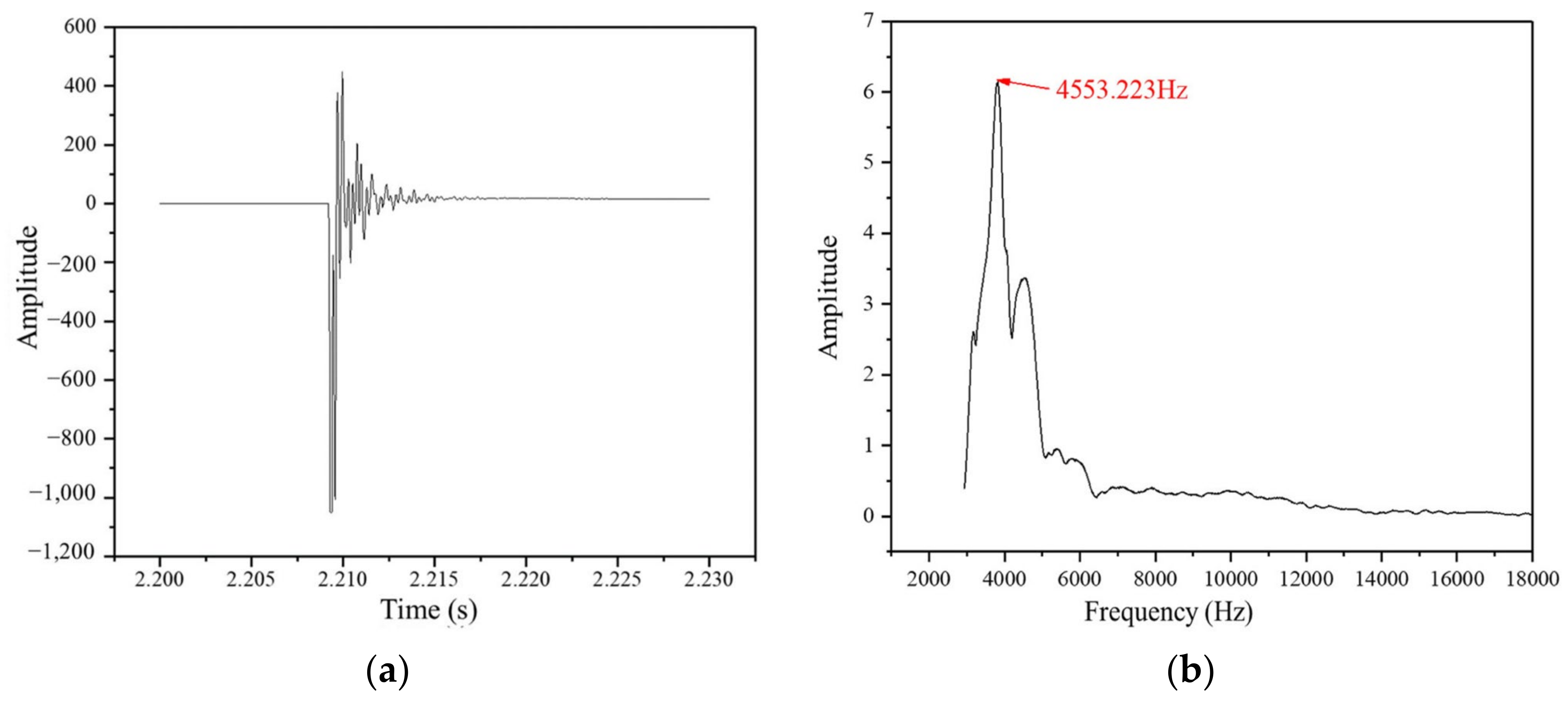
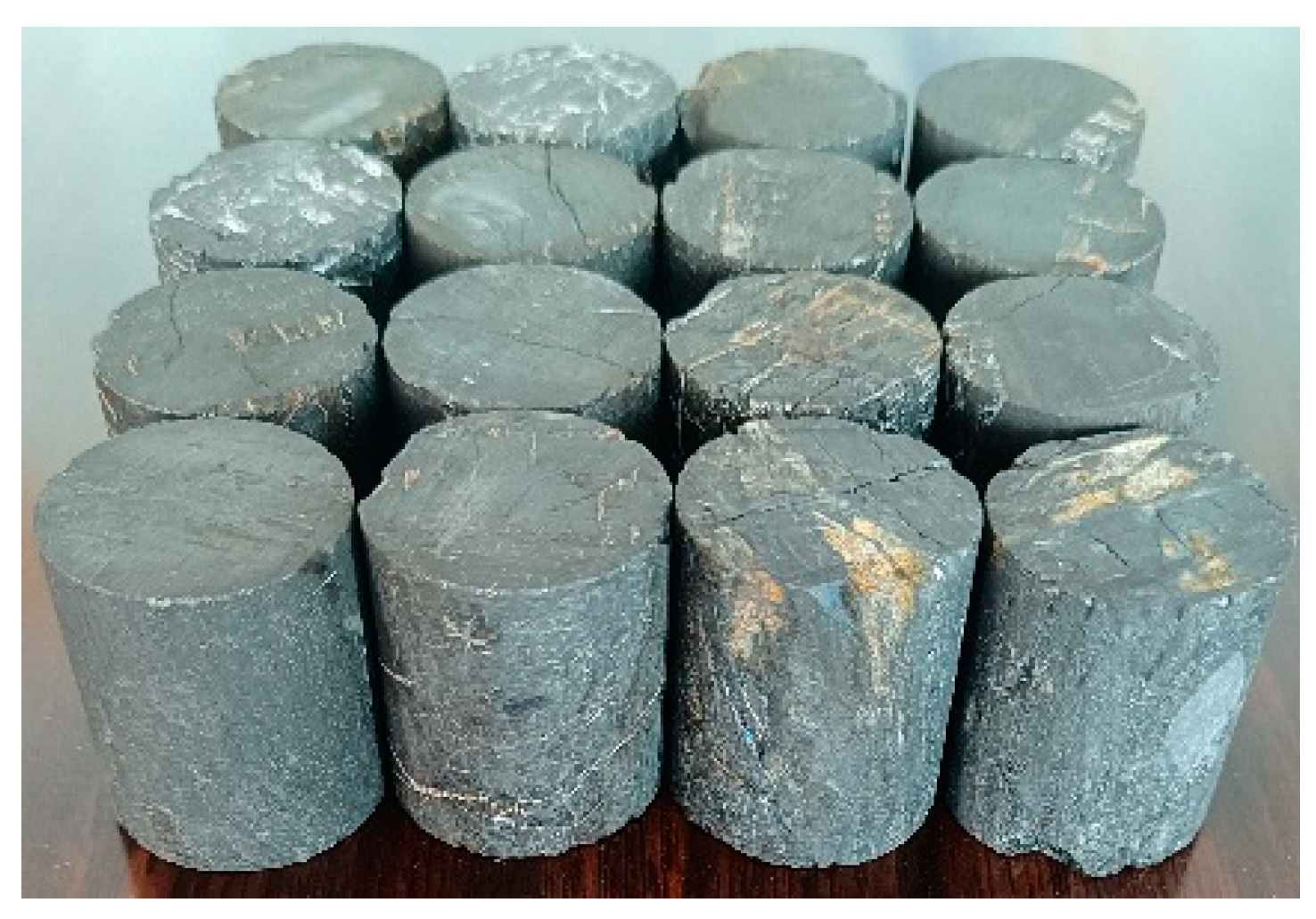



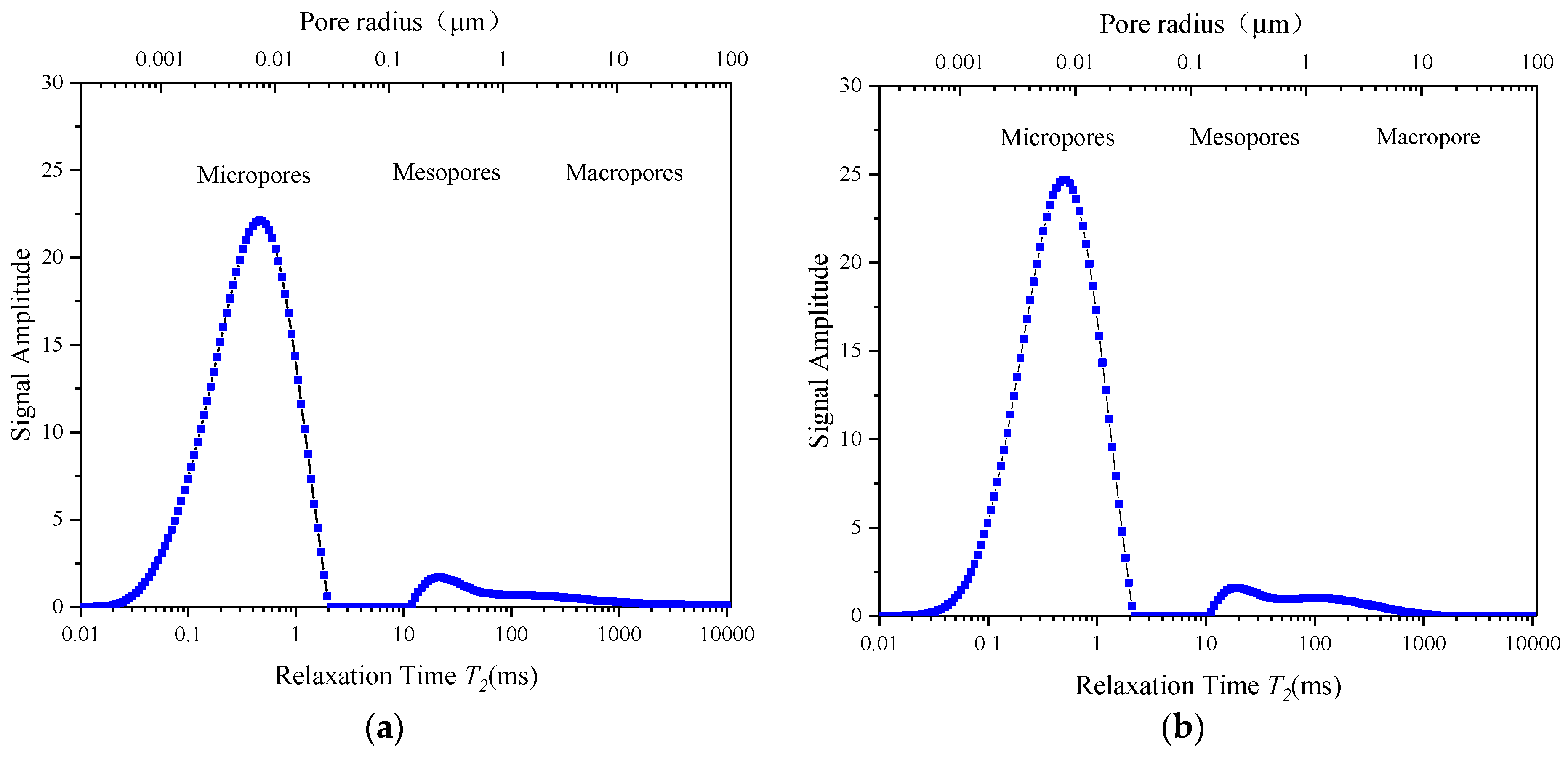



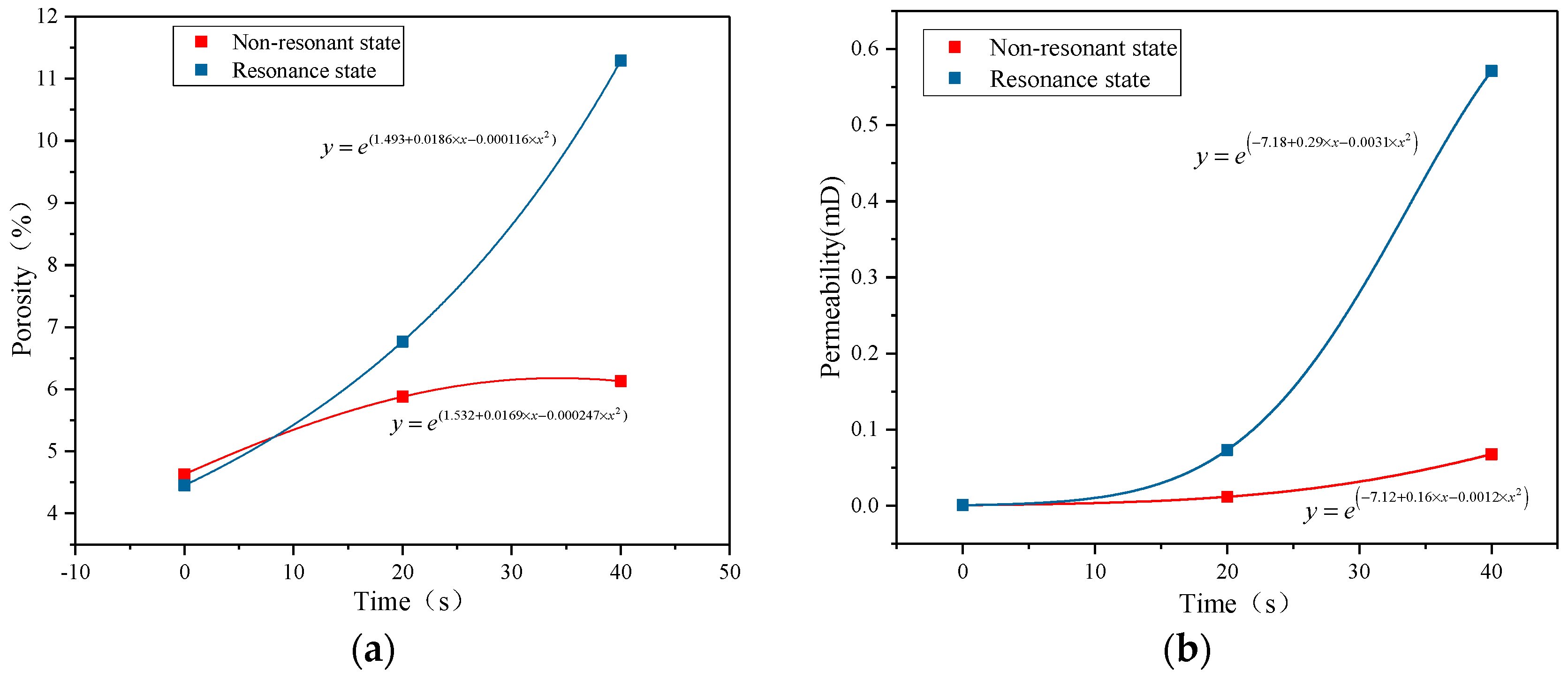


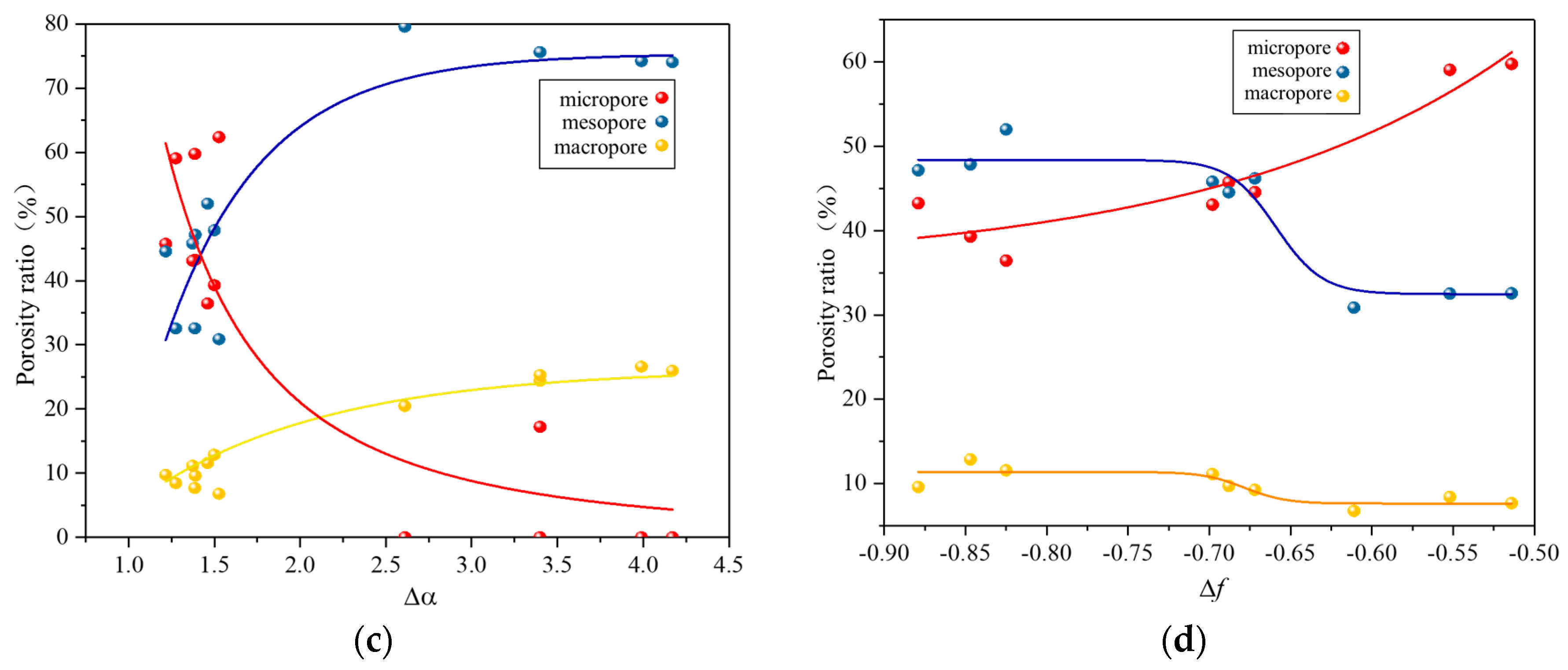
| Samples | D/mm | H/mm | Compressive Strength/MPa |
| Y1 | 49.42 | 102.71 | 7.31 |
| Y2 | 50.12 | 100.84 | 10.64 |
| Y3 | 50.62 | 101.54 | 6.14 |
| Samples | D/mm | H/mm | Tensile strength/MPa |
| SL1 | 49.13 | 25.22 | 0.79 |
| L2 | 49.58 | 24.72 | 0.99 |
| L3 | 49.70 | 24.87 | 6.69 |
| Frequency/kHz | Amplitude/μm | Static Load/MPa | Load Area/mm2 | Power/kW |
|---|---|---|---|---|
| 15.20 | 70 | 0~1 | 176.7 | 1.5 |
| Samples | Time | Porosity Ratio (%) | Dmax | Dmin | ΔD(q) | Δα | Δf | ||
|---|---|---|---|---|---|---|---|---|---|
| Micropore | Mesopore | Macropore | |||||||
| H1 | 0 | 43.24 | 47.15 | 9.61 | 3.326 | 0.888 | 2.438 | 1.388 | −0.879 |
| 40 | 44.55 | 46.18 | 9.27 | 4.230 | 0.891 | 3.339 | 3.399 | −0.672 | |
| 80 | 36.43 | 51.99 | 11.58 | 3.849 | 0.872 | 2.977 | 1.460 | −0.825 | |
| H2 | 0 | 45.74 | 44.54 | 9.72 | 3.876 | 0.897 | 2.979 | 1.216 | −0.688 |
| 40 | 43.08 | 45.79 | 11.13 | 3.890 | 0.895 | 2.995 | 1.373 | −0.698 | |
| 80 | 39.29 | 47.84 | 12.87 | 3.897 | 0.889 | 3.008 | 1.499 | −0.847 | |
Disclaimer/Publisher’s Note: The statements, opinions and data contained in all publications are solely those of the individual author(s) and contributor(s) and not of MDPI and/or the editor(s). MDPI and/or the editor(s) disclaim responsibility for any injury to people or property resulting from any ideas, methods, instructions or products referred to in the content. |
© 2024 by the authors. Licensee MDPI, Basel, Switzerland. This article is an open access article distributed under the terms and conditions of the Creative Commons Attribution (CC BY) license (https://creativecommons.org/licenses/by/4.0/).
Share and Cite
Zhang, L.; Wang, X.; Niu, Z. Experimental Study on the Impact of High-Frequency Vibration Excitation on Coal Fracturing. Fractal Fract. 2024, 8, 546. https://doi.org/10.3390/fractalfract8090546
Zhang L, Wang X, Niu Z. Experimental Study on the Impact of High-Frequency Vibration Excitation on Coal Fracturing. Fractal and Fractional. 2024; 8(9):546. https://doi.org/10.3390/fractalfract8090546
Chicago/Turabian StyleZhang, Lei, Xufeng Wang, and Zhijun Niu. 2024. "Experimental Study on the Impact of High-Frequency Vibration Excitation on Coal Fracturing" Fractal and Fractional 8, no. 9: 546. https://doi.org/10.3390/fractalfract8090546
APA StyleZhang, L., Wang, X., & Niu, Z. (2024). Experimental Study on the Impact of High-Frequency Vibration Excitation on Coal Fracturing. Fractal and Fractional, 8(9), 546. https://doi.org/10.3390/fractalfract8090546







